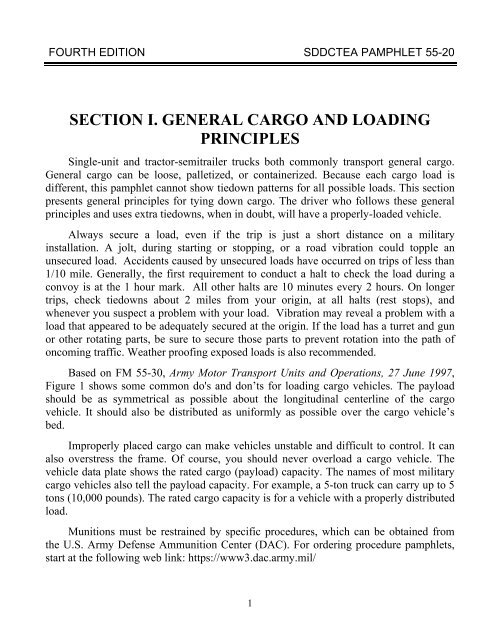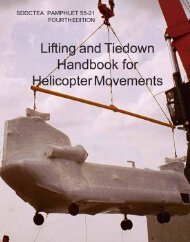TEA PAM 55-20 Tiedown Handbook for Truck - Military Surface ...
TEA PAM 55-20 Tiedown Handbook for Truck - Military Surface ...
TEA PAM 55-20 Tiedown Handbook for Truck - Military Surface ...
You also want an ePaper? Increase the reach of your titles
YUMPU automatically turns print PDFs into web optimized ePapers that Google loves.
FOURTH EDITION SDDC<strong>TEA</strong> <strong>PAM</strong>PHLET <strong>55</strong>-<strong>20</strong><br />
SECTION I. GENERAL CARGO AND LOADING<br />
PRINCIPLES<br />
Single-unit and tractor-semitrailer trucks both commonly transport general cargo.<br />
General cargo can be loose, palletized, or containerized. Because each cargo load is<br />
different, this pamphlet cannot show tiedown patterns <strong>for</strong> all possible loads. This section<br />
presents general principles <strong>for</strong> tying down cargo. The driver who follows these general<br />
principles and uses extra tiedowns, when in doubt, will have a properly-loaded vehicle.<br />
Always secure a load, even if the trip is just a short distance on a military<br />
installation. A jolt, during starting or stopping, or a road vibration could topple an<br />
unsecured load. Accidents caused by unsecured loads have occurred on trips of less than<br />
1/10 mile. Generally, the first requirement to conduct a halt to check the load during a<br />
convoy is at the 1 hour mark. All other halts are 10 minutes every 2 hours. On longer<br />
trips, check tiedowns about 2 miles from your origin, at all halts (rest stops), and<br />
whenever you suspect a problem with your load. Vibration may reveal a problem with a<br />
load that appeared to be adequately secured at the origin. If the load has a turret and gun<br />
or other rotating parts, be sure to secure those parts to prevent rotation into the path of<br />
oncoming traffic. Weather proofing exposed loads is also recommended.<br />
Based on FM <strong>55</strong>-30, Army Motor Transport Units and Operations, 27 June 1997,<br />
Figure 1 shows some common do's and don’ts <strong>for</strong> loading cargo vehicles. The payload<br />
should be as symmetrical as possible about the longitudinal centerline of the cargo<br />
vehicle. It should also be distributed as uni<strong>for</strong>mly as possible over the cargo vehicle’s<br />
bed.<br />
Improperly placed cargo can make vehicles unstable and difficult to control. It can<br />
also overstress the frame. Of course, you should never overload a cargo vehicle. The<br />
vehicle data plate shows the rated cargo (payload) capacity. The names of most military<br />
cargo vehicles also tell the payload capacity. For example, a 5-ton truck can carry up to 5<br />
tons (10,000 pounds). The rated cargo capacity is <strong>for</strong> a vehicle with a properly distributed<br />
load.<br />
Munitions must be restrained by specific procedures, which can be obtained from<br />
the U.S. Army Defense Ammunition Center (DAC). For ordering procedure pamphlets,<br />
start at the following web link: https://www3.dac.army.mil/<br />
1





